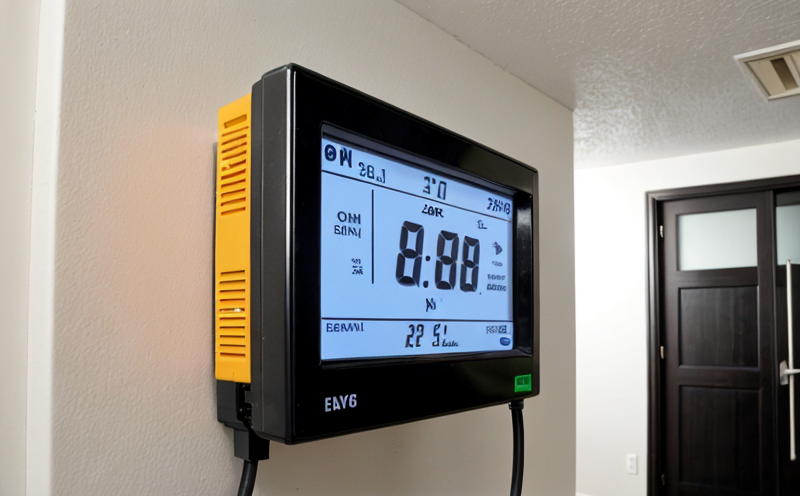ASHRAE 189.1 Green Building Energy Efficiency Testing
The ASHRAE Standard 189.1 is a green building standard that focuses on sustainable design, construction, and operation of buildings. This standard sets energy efficiency requirements for commercial buildings, including single-family dwellings built as part of a planned development of four or more units. The goal is to reduce the environmental impact of buildings by promoting sustainable design practices.
The ASHRAE 189.1 Green Building Energy Efficiency Testing specifically targets compliance with Section 6: Building Energy Performance and Equipment, Clause 6.3: Compliance Methods for Building Energy Consumption Estimates. This clause mandates that building owners or operators must demonstrate compliance through either direct measurement of energy use or a validated simulation model.
The testing process involves detailed analysis using computer simulations to predict the actual energy consumption of the building. The simulation models used in this test are based on ASHRAE 189.1 and other relevant standards such as ISO 52067-2, which provides guidelines for measuring the energy performance of buildings.
The test requires a comprehensive understanding of the building's design, including HVAC systems, lighting, and other major energy-consuming components. The testing team will work closely with the project stakeholders to gather all necessary data and information required for accurate simulation modeling.
Once the simulation model is established, it undergoes rigorous validation procedures to ensure its accuracy. This involves comparing the predicted values against actual performance metrics obtained from similar buildings or through direct measurements in the target building. The results of these validations are documented thoroughly and submitted as part of the final report.
The testing process also includes detailed documentation of all assumptions made during the simulation, along with any adjustments applied to align predictions more closely with observed data points. This transparency ensures that potential discrepancies between predicted and actual performance can be identified and addressed effectively.
In summary, ASHRAE 189.1 Green Building Energy Efficiency Testing provides a robust framework for ensuring that new or renovated commercial buildings meet stringent energy efficiency requirements set forth by this standard. By leveraging advanced simulation techniques combined with comprehensive validation procedures, we offer reliable evidence supporting compliance with these important sustainability goals.
Why Choose This Test
Choosing ASHRAE 189.1 Green Building Energy Efficiency Testing offers numerous advantages for those involved in the design and operation of commercial buildings. Compliance with this standard is not only beneficial from an environmental perspective but also provides significant cost savings over time.
- Cost Savings: By ensuring efficient use of resources, you can reduce operational costs associated with heating, cooling, lighting, etc.
- Improved Reputation: Demonstrating commitment to sustainability enhances your organization's reputation among clients and stakeholders.
- Regulatory Compliance: Many regions now require compliance with green building standards like ASHRAE 189.1, making this testing essential for avoiding penalties or delays in project delivery.
- Enhanced Performance: The detailed analysis provided by our tests helps identify areas where further improvements could be made to enhance overall performance even beyond the minimum requirements of the standard.
In addition to these benefits, choosing ASHRAE 189.1 Green Building Energy Efficiency Testing ensures that your building meets high standards for energy efficiency, contributing positively towards global efforts aimed at reducing carbon footprints and promoting sustainable development practices.
International Acceptance and Recognition
- Australia: ASHRAE 189.1 is widely recognized in Australia for its role in promoting green building practices, with many projects seeking certification based on this standard.
- New Zealand: Similarly, New Zealand has adopted several aspects of the ASHRAE Standard into their local regulations, reflecting its global significance.
- United Kingdom: The UK's Green Building Council incorporates principles from ASHRAE 189.1 in its own guidelines for sustainable building design and construction.
- Countries in the European Union: Many EU member states use ASHRAE 189.1 as a benchmark for assessing energy performance of buildings, aligning with broader European Union directives on climate change mitigation strategies.
The widespread adoption across various countries underscores the importance and relevance of this standard in promoting sustainable urban development worldwide.
Environmental and Sustainability Contributions
Beyond mere compliance, adopting ASHRAE 189.1 Green Building Energy Efficiency Testing contributes significantly to environmental sustainability through several key mechanisms:
Reduction in Carbon Footprint: By optimizing energy use within buildings, we help decrease overall greenhouse gas emissions contributing to climate change.
Promotion of Renewable Resources: Encouraging efficient utilization of renewable resources such as solar power or geothermal heating can lead to reduced dependency on non-renewable sources.
Enhanced Resource Efficiency: Implementing measures outlined in this standard improves water efficiency, waste management practices, and other resource conservation initiatives within buildings.
Healthier Indoor Environment: Efficient HVAC systems reduce pollutants indoors while maintaining optimal temperature levels, leading to healthier living environments for occupants.
Economic Benefits: While initial investments may seem high, long-term savings from reduced utility bills and increased asset value make these projects worthwhile financially as well as environmentally.
In essence, ASHRAE 189.1 Green Building Energy Efficiency Testing plays a crucial role in fostering sustainable growth by integrating environmental considerations into every aspect of building design and operation.





